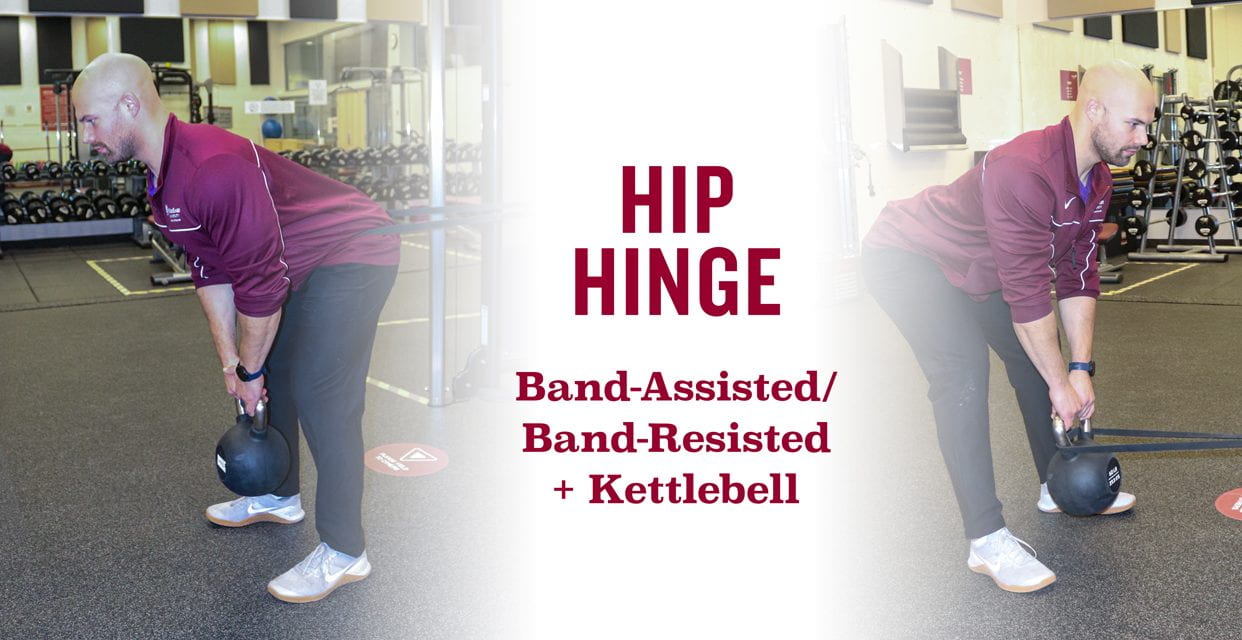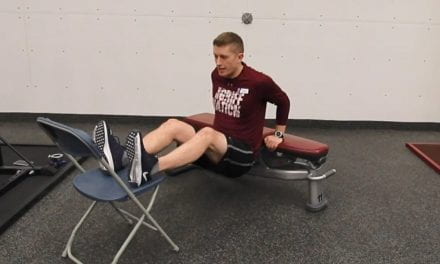One of the key movement patterns individuals should master early in their fitness journey is the hip hinge. Sometimes we struggle with the basics and need to use some biofeedback to encourage our bodies to move the way we want them to.
Objective
- The primary goal of the Band Assisted Kettlebell Hip Hinge is to allow you to focus on maintaining an upright posture while you have an implement in your hand. The band tension around your hips encourages your hips to drive back instead of downwards, especially if you are struggling to maintain a hip dominant position.
- This is a good drill for those who struggle with the knees shooting forward in the deadlift.
- The primary goal of the Band Resisted Kettlebell Hip Hinge is to encourage activation of the latissimus dorsi by forcing you to keep tension on the kettlebell throughout the entire movement. By encouraging activation of the lats, it will become easier for you to maintain a neutral spine position as you progress through your deadlifts.
- This is a good drill for those who find their shoulders rolling forward, or losing tension in their back as they deadlift.
Joints Targeted
- The primary joint of movement will be through the hips, there is also a requirement of the intervertebral joints (the joints of the spinal column) to create stability during the movement.
Muscle Groups Targeted
-
Agonists
-
- Semimembranosus
- Semitendinosus
- Biceps Femoris
- Gluteal muscles
-
Stabilizing muscles
-
- Erector spinae
- Rectus abdominis
- Internal/external obliques
- Gluteus minimus/minimus
- Gastrocnemius
Band Assisted Kettlebell Hip Hinge
Starting Position
- Start with a band around your waist and securely anchored to a wall or pillar at or slightly above hip height, with enough distance so you can comfortably hip hinge.
- With the band secured around your hips and a light-ish kettlebell in your hands, move forward until you feel enough tension to gently pull your hips back but it should not feel like the band is going to rip you backward.
- Position your feet approximately shoulder-width apart with both hands gripping the kettlebell
- Set your shoulders while gripping the kettlebell by cranking your pinkies into the kettlebell (Packing your shoulders), then unlock your knees
Movement
- In a controlled manner, maintaining the proper posture of your torso and shoulders by keeping your shoulders “packed”
- Allow your hips to drift back using the tension of the band to guide you as you focus on maintaining the “packed” shoulder position allowing yourself into the “wedge” position
- When your hamstrings can no longer stretch any further or when the kettlebell touches the ground pause, doing a self-check on position then begin to slide your hips forward. Making sure to maintain that “packed” shoulder position
Band Resisted Kettlebell Hip Hinge
Starting Position
- Anchor a band securely a foot or less from the ground, securely loop the band through the handle of the kettlebell.
- With the band secured to a light-ish kettlebell and the wall with you facing the wall step back until you feel a moderate amount of tension on the kettlebell. It should not feel like the kettlebell will come flying out of your hand.
- Position your feet approximately shoulder-width apart with both hands gripping the kettlebell
- Set your shoulders while gripping the kettlebell by cranking your pinkies into the kettlebell (packing your shoulders), then unlock your knees. You should need to pull the kettlebell in towards your body slightly at the top of the movement.
Movement
- In a controlled manner, maintaining the proper posture of your torso and shoulders by keeping your shoulders “packed”
- Allowing your hips to drift back as you maintain proper posture focusing on keeping tension in your lats and shoulders.
- When your hamstrings can no longer stretch any further or when the kettlebell touches the ground pause, doing a self-check on position then begin to slide your hips forward, reversing out of the position.
- As you begin to slowly extend your hips you will feel the kettlebell wanting to move away from your body and you will have to gently increase the tension through your shoulders to ensure the kettlebell moves upwards in a straight line.
Recommended sets and repetitions
- If you are just learning the movement do five to 10 reps making sure you have maintained proper spinal position during each movement.
- As you become more confident in your movements move your feet away from the wall an inch or two then repeat five reps.
- Continue for one to five sets until you can either get your torso Parallel to the ground or you cannot reach the wall with your butt while you maintain proper spinal position.
Check out Learning to Deadlift-Hip Hinge Part 2 A/B
Visit our website for information on training consultations, virtual coaching, plus individual and group personal training. If you’re ready to work with one of our Exercise Specialists, fill out the consultation form so we can connect you with the best trainer to help you meet your goals. Sign-up to receive our monthly newsletter for news, announcements, program information, swim tips, and exercise demos.
by Kyle Babiuk
Kyle is a Bachelor of Kinesiology Graduate and is certified with the Canadian Society for Exercise Physiologists. He specializes in movement analysis, chronic disease management through exercise and strength programming. He’s worked with athletes, individuals with chronic diseases, along with many other individuals trying to achieve their health and fitness goals.




